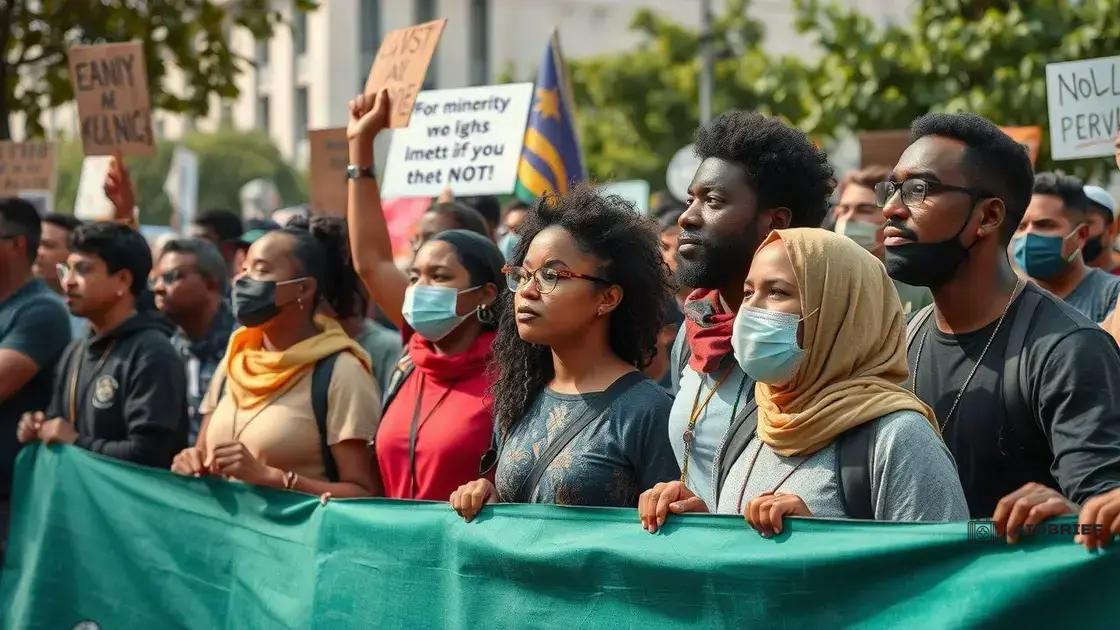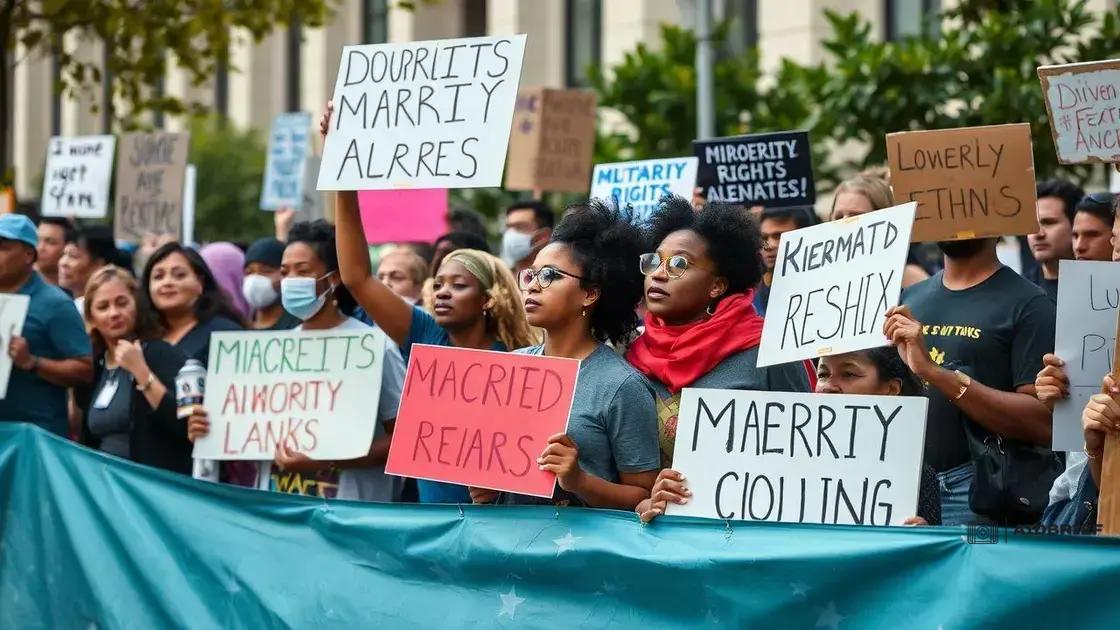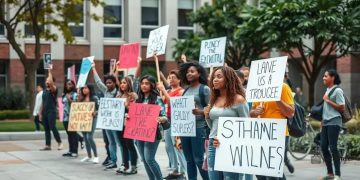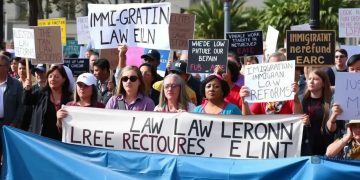Minority rights advocacy campaigns that drive real change

Minority rights advocacy campaigns are essential for promoting equality and justice, involving community engagement, clear objectives, and effective storytelling to drive impactful change.
Minority rights advocacy campaigns are vital in shaping policies that promote equality and justice for marginalized groups. Have you ever considered how these initiatives can foster real change in society?
Understanding minority rights advocacy
Understanding minority rights advocacy is essential for anyone who wishes to promote equality and justice. These campaigns focus on the needs and concerns of marginalized groups, ensuring their voices are heard.
What is Minority Rights Advocacy?
Minority rights advocacy seeks to protect and promote the rights of individuals who belong to smaller or marginalized groups. This includes racial and ethnic minorities, LGBTQ+ individuals, and those with disabilities. The aim is to create a fairer society where everyone has equal opportunities and access to resources.
Key Principles of Advocacy
Effective advocacy revolves around several core principles:
- Inclusivity: Ensuring all voices are represented.
- Awareness: Educating the public about issues faced by minorities.
- Collaboration: Working with various organizations to strengthen efforts.
- Empowerment: Encouraging minority groups to take part in decision-making.
These principles guide advocates as they work to influence policies and promote change. They serve as a foundation for campaigns, helping to rally support from the community and stakeholders.
Advocacy is not only about raising awareness but also about taking action. For example, organizations often organize events, workshops, and discussions. These initiatives aim to empower individuals and educate them about their rights.
Challenges in Minority Rights Advocacy
Advocates face numerous challenges, including resistance to change and lack of funding. Additionally, many minorities face stigma, making it difficult for their concerns to be taken seriously. Despite these hurdles, persistence is key.
Successful advocacy requires determination and strategic efforts to navigate these challenges. By collaborating with allies and utilizing social media or other platforms, advocates can share their messages widely. This approach helps to counteract negativity and build support for minority rights.
Key elements of successful campaigns
Successful minority rights advocacy campaigns share key elements that contribute to their effectiveness. Understanding these elements can significantly impact their influence and outreach.
Clear Goals and Objectives
One essential element is having clear goals. Campaigns should define what they aim to achieve, whether it’s raising awareness, influencing legislation, or changing public perception. Specific objectives help in measuring success and guiding the campaign’s direction.
Engaging Storytelling
Engaging storytelling is another powerful tool in advocacy. Sharing personal stories from individuals impacted by minority rights issues can create emotional connections with the audience. This approach helps to humanize the cause and can mobilize support.
- Use real-life examples.
- Share video testimonials.
- Highlight community experiences.
These stories can resonate deeply and inspire action, making them a cornerstone of effective campaigns.
Community Involvement
Community involvement enhances campaigns by fostering a sense of ownership among supporters. When communities are actively engaged, they contribute to strategies and spread awareness more effectively. Encourage individuals to participate in planning events and outreach activities. This collaborative spirit can amplify the campaign’s reach.
Additionally, leveraging social media platforms allows advocates to connect with larger audiences. Regular updates and interactive posts can keep momentum and interest alive throughout the campaign.
Strong Partnerships
Building strong partnerships with organizations, influencers, and stakeholders can provide necessary resources and support. Collaborating with groups that share similar goals can enhance credibility and broaden the audience base.
Advocates can also share knowledge and strategies, strengthening collective efforts. By joining forces, campaigns can often accomplish more than they could independently.
Case studies of impactful advocacy

Analyzing case studies of impactful advocacy provides valuable insights into the effectiveness of different strategies. These examples showcase how advocacy campaigns can lead to meaningful change.
Example 1: The Civil Rights Movement
The Civil Rights Movement in the 1960s is a prominent example of successful advocacy. Driven by leaders like Martin Luther King Jr., activists used peaceful protests, marches, and powerful speeches to demand equal rights for African Americans.
This movement achieved significant legislative victories, including the Voting Rights Act of 1965. By organizing large-scale events and fostering community involvement, advocates brought national attention to their cause, changing public opinion and policy.
Example 2: Marriage Equality
Another impactful case is the fight for marriage equality in the United States. Organizations such as the Human Rights Campaign played crucial roles in raising awareness and mobilizing support.
Through effective storytelling and strategic lobbying, advocates shifted perspectives on LGBTQ+ rights. The culmination of these efforts was the landmark Supreme Court decision in Obergefell v. Hodges in 2015, which legalized same-sex marriage across the country.
- Highlighting personal stories helped create empathy.
- Building coalitions with other civil rights organizations strengthened their message.
- Utilizing social media to share successes and challenges increased engagement.
This case illustrates how advocacy can evolve and adapt, leading to significant societal changes.
Example 3: Indigenous Rights Movements
Indigenous rights movements worldwide highlight another area of impactful advocacy. In countries like Canada and Australia, Indigenous people have fought for land rights and recognition of their cultures.
Campaigns often involve legal action, protests, and education to raise awareness about injustices faced by Indigenous communities. Successful initiatives have led to land restoration and increased acknowledgment of Indigenous rights.
Each case study reveals common themes: clarity of goals, strong community involvement, and effective communication strategies. By learning from these examples, future campaigns can apply these principles to achieve their objectives effectively.
Challenges faced in minority rights campaigns
Minoritiy rights campaigns face various challenges that can hinder progress and effectiveness. Understanding these challenges is crucial for advocates striving to make a difference.
Resistance to Change
One significant challenge is the resistance to change within society. Many people have deeply rooted beliefs and biases that can affect their views on minority rights. Changing these perceptions requires persistent advocacy and education.
Lack of Funding
Limited financial resources can severely restrict a campaign’s ability to reach its target audience. Without sufficient funding, it becomes challenging to organize events, produce materials, or run effective advertising campaigns.
- Successful campaigns often rely on donations and grants.
- Building partnerships with organizations can provide additional resources.
- Creative fundraising strategies can help support initiatives.
Every dollar counts, and innovative fundraising can be essential to overcoming this obstacle.
Divisions within the Community
Another challenge is the divisions that can exist within the minority community itself. Different groups may have varying priorities, making it difficult to present a unified front.
Successfully addressing these divisions requires open dialogue and collaboration. By listening to diverse perspectives, advocates can work towards common goals while respecting individual needs.
Media Representation
Media portrayal can significantly impact how minority issues are perceived. Often, the media focuses on sensational stories rather than the real issues facing these communities. This can lead to misunderstandings and undermine the hard work of advocates.
Campaigns must actively engage with the media to ensure accurate representation of their cause. This includes providing compelling stories and data to help shape a more informed public discourse.
Ultimately, recognizing and addressing these challenges is vital for successful advocacy. By developing strategies to overcome obstacles, campaigns can create lasting change and advance the rights of minorities.
Ways to get involved in advocacy
Getting involved in advocacy is a powerful way to support minority rights and drive change in your community. There are many avenues one can explore to make a meaningful impact.
Join Local Organizations
One effective way to get involved is by joining local organizations focused on advocacy. These groups often have established resources and networks that can amplify your efforts.
- Find organizations that align with your values.
- Participate in meetings and trainings.
- Engage in community outreach programs.
Being part of a group helps you connect with others and learn more about effective advocacy.
Volunteer for Campaigns
Volunteering for campaigns is another great opportunity. Many advocates need help with events, logistics, and outreach. Whether it’s helping at a rally or distributing informational materials, your support can make a tangible difference.
Additionally, volunteering can provide hands-on experience, allowing you to learn from seasoned advocates. It helps build skills that are valuable in advocacy efforts, such as public speaking and organization.
Use Social Media
Social media platforms offer powerful tools for advocacy. Sharing informative content, personal stories, and updates can help raise awareness about minority rights issues.
Consider using hashtags, engaging with others, and joining online discussions. This type of activism can reach a wide audience and encourage others to get involved.
Attend Workshops and Training Sessions
Participating in workshops and training sessions can equip you with important tools and knowledge. Many organizations offer programs that teach advocacy strategies, public speaking, and community organizing skills.
These educational opportunities are great for those who want to deepen their understanding of advocacy and learn best practices. Knowledge empowers action, making you a more effective advocate.
Every step you take in advocacy matters. Whether you choose to join a local organization, volunteer, or make use of social media, your involvement helps build a stronger movement for minority rights.
FAQ – Frequently Asked Questions About Minority Rights Advocacy
How can I get involved in minority rights advocacy?
You can get involved by joining local organizations, volunteering for campaigns, or using social media to raise awareness about minority rights issues.
What are the main challenges faced in minority rights campaigns?
Some challenges include resistance to change, lack of funding, divisions within the community, and media representation of minority issues.
Why is storytelling important in advocacy?
Storytelling is crucial because it creates emotional connections and helps to humanize the issues faced by minorities, fostering greater empathy and support.
What actions can individuals take to make a difference?
Individuals can volunteer, attend workshops, share their experiences, and engage in social media discussions to support minority rights and advocate for change.





